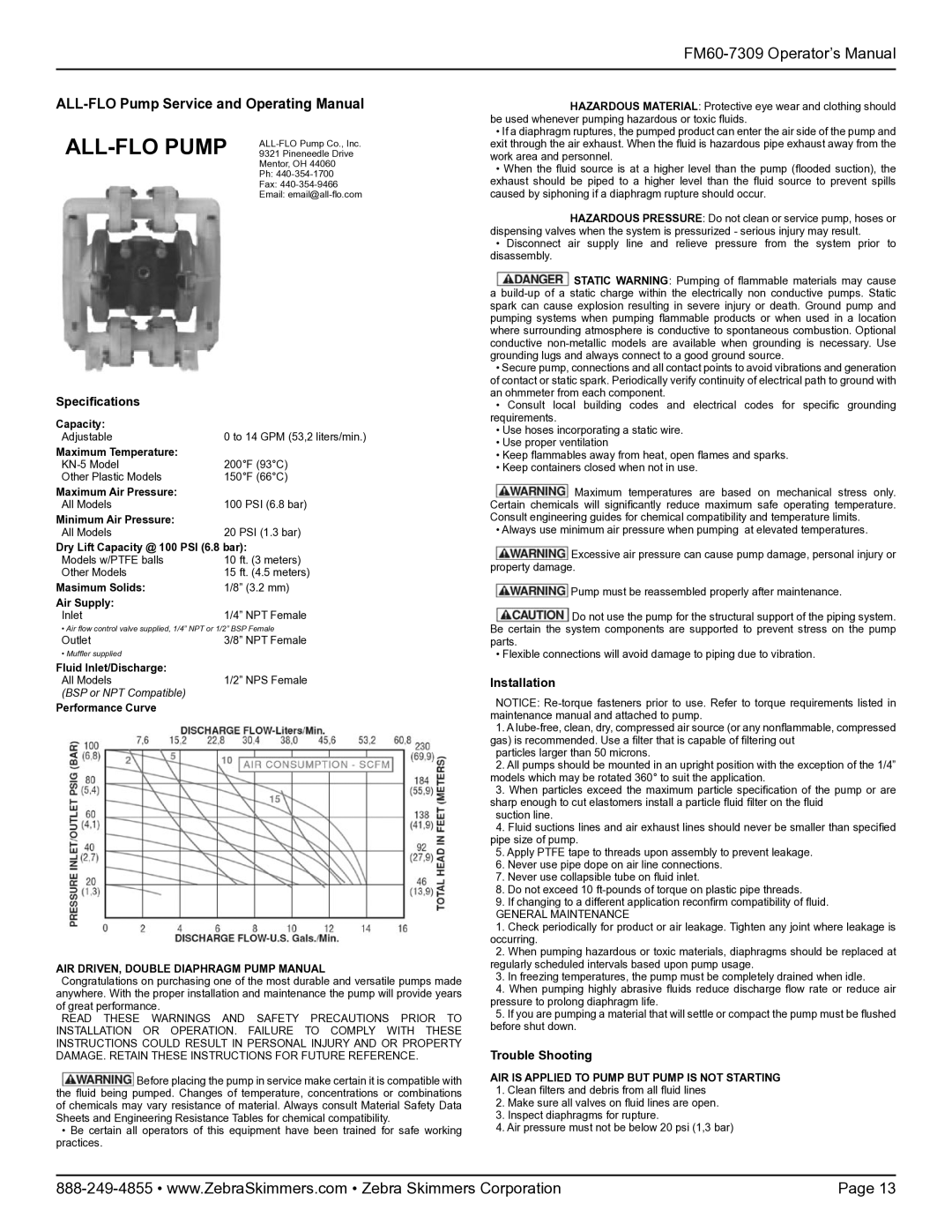
| |
9321 Pineneedle Drive | |
| Mentor, OH 44060 |
| Ph: |
| Fax: |
| Email: |
Specifications
Capacity: |
|
Adjustable | 0 to 14 GPM (53,2 liters/min.) |
Maximum Temperature: |
|
200°F (93°C) | |
Other Plastic Models | 150°F (66°C) |
Maximum Air Pressure: |
|
All Models | 100 PSI (6.8 bar) |
Minimum Air Pressure: |
|
All Models | 20 PSI (1.3 bar) |
Dry Lift Capacity @ 100 PSI (6.8 bar): | |
Models w/PTFE balls | 10 ft. (3 meters) |
Other Models | 15 ft. (4.5 meters) |
Masimum Solids: | 1/8” (3.2 mm) |
Air Supply: |
|
Inlet | 1/4” NPT Female |
• Air flow control valve supplied, 1/4” NPT or 1/2” BSP Female | |
Outlet | 3/8” NPT Female |
• Muffler supplied |
|
Fluid Inlet/Discharge: |
|
All Models | 1/2” NPS Female |
(BSP or NPT Compatible) |
|
Performance Curve
AIR DRIVEN, DOUBLE DIAPHRAGM PUMP MANUAL
Congratulations on purchasing one of the most durable and versatile pumps made anywhere. With the proper installation and maintenance the pump will provide years of great performance.
READ THESE WARNINGS AND SAFETY PRECAUTIONS PRIOR TO INSTALLATION OR OPERATION. FAILURE TO COMPLY WITH THESE INSTRUCTIONS COULD RESULT IN PERSONAL INJURY AND OR PROPERTY DAMAGE. RETAIN THESE INSTRUCTIONS FOR FUTURE REFERENCE.
![]() Before placing the pump in service make certain it is compatible with the fluid being pumped. Changes of temperature, concentrations or combinations of chemicals may vary resistance of material. Always consult Material Safety Data Sheets and Engineering Resistance Tables for chemical compatibility.
Before placing the pump in service make certain it is compatible with the fluid being pumped. Changes of temperature, concentrations or combinations of chemicals may vary resistance of material. Always consult Material Safety Data Sheets and Engineering Resistance Tables for chemical compatibility.
•Be certain all operators of this equipment have been trained for safe working practices.
HAZARDOUS MATERIAL: Protective eye wear and clothing should be used whenever pumping hazardous or toxic fluids.
•If a diaphragm ruptures, the pumped product can enter the air side of the pump and exit through the air exhaust. When the fluid is hazardous pipe exhaust away from the work area and personnel.
•When the fluid source is at a higher level than the pump (flooded suction), the exhaust should be piped to a higher level than the fluid source to prevent spills caused by siphoning if a diaphragm rupture should occur.
HAZARDOUS PRESSURE: Do not clean or service pump, hoses or dispensing valves when the system is pressurized - serious injury may result.
•Disconnect air supply line and relieve pressure from the system prior to disassembly.
![]() STATIC WARNING: Pumping of flammable materials may cause a
STATIC WARNING: Pumping of flammable materials may cause a
•Secure pump, connections and all contact points to avoid vibrations and generation of contact or static spark. Periodically verify continuity of electrical path to ground with an ohmmeter from each component.
•Consult local building codes and electrical codes for specific grounding requirements.
•Use hoses incorporating a static wire.
•Use proper ventilation
•Keep flammables away from heat, open flames and sparks.
•Keep containers closed when not in use.
![]() Maximum temperatures are based on mechanical stress only. Certain chemicals will significantly reduce maximum safe operating temperature. Consult engineering guides for chemical compatibility and temperature limits.
Maximum temperatures are based on mechanical stress only. Certain chemicals will significantly reduce maximum safe operating temperature. Consult engineering guides for chemical compatibility and temperature limits.
• Always use minimum air pressure when pumping at elevated temperatures.
![]() Excessive air pressure can cause pump damage, personal injury or property damage.
Excessive air pressure can cause pump damage, personal injury or property damage.
![]() Pump must be reassembled properly after maintenance.
Pump must be reassembled properly after maintenance.
![]() Do not use the pump for the structural support of the piping system. Be certain the system components are supported to prevent stress on the pump parts.
Do not use the pump for the structural support of the piping system. Be certain the system components are supported to prevent stress on the pump parts.
• Flexible connections will avoid damage to piping due to vibration.
Installation
NOTICE:
1.A
particles larger than 50 microns.
2.All pumps should be mounted in an upright position with the exception of the 1/4” models which may be rotated 360° to suit the application.
3.When particles exceed the maximum particle specification of the pump or are sharp enough to cut elastomers install a particle fluid filter on the fluid
suction line.
4.Fluid suctions lines and air exhaust lines should never be smaller than specified pipe size of pump.
5.Apply PTFE tape to threads upon assembly to prevent leakage.
6.Never use pipe dope on air line connections.
7.Never use collapsible tube on fluid inlet.
8.Do not exceed 10
9.If changing to a different application reconfirm compatibility of fluid.
GENERAL MAINTENANCE
1.Check periodically for product or air leakage. Tighten any joint where leakage is occurring.
2.When pumping hazardous or toxic materials, diaphragms should be replaced at regularly scheduled intervals based upon pump usage.
3.In freezing temperatures, the pump must be completely drained when idle.
4.When pumping highly abrasive fluids reduce discharge flow rate or reduce air pressure to prolong diaphragm life.
5.If you are pumping a material that will settle or compact the pump must be flushed before shut down.
Trouble Shooting
AIR IS APPLIED TO PUMP BUT PUMP IS NOT STARTING
1.Clean filters and debris from all fluid lines
2.Make sure all valves on fluid lines are open.
3.Inspect diaphragms for rupture.
4.Air pressure must not be below 20 psi (1,3 bar)
Page 13 |
